Set up a new import feed
Create a feed that you can use to import content in bulk using MRSS feeds
If you have a valid Media Really Simple Syndication (MRSS) feed for your collection of videos, you can bulk import those videos and associated content into your account. Using your dashboard, you can upload all your videos, register your videos, and import metadata associated with your videos in one single workflow.
Before bulk importing your videos, be sure to review the FAQs at the end of this article and limit your MRSS feed to 1,000 videos. If you have more than 1,000 videos in your feed, split them into groups of 1,000 or less.
Additionally, any configuration changes will not apply retroactively to assets that have already been ingested.
If you are a developer or have developer resources, you can use the Management API to set up an MRSS import feed.
Implementation
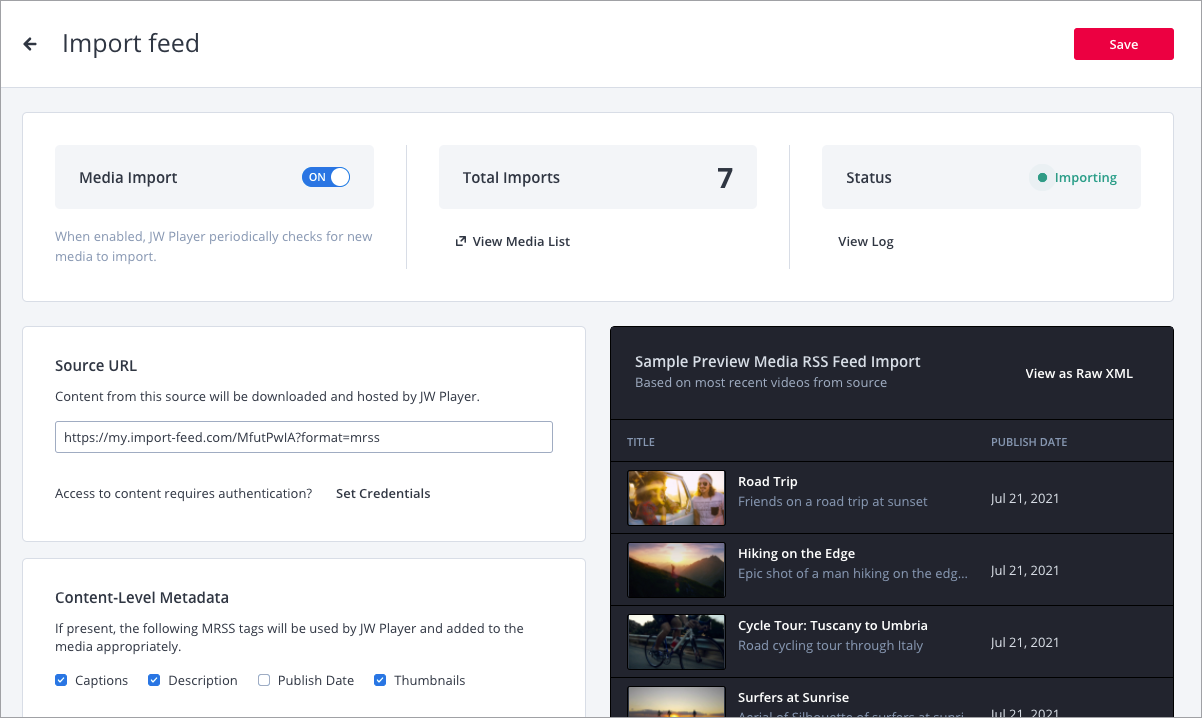
Import settings screen
You can set up, define, activate, review, and delete an import feed from your JWX dashboard. The following sections explain how to complete these tasks.
For DRM-enabled properties, DRM applies to all imported media by default. If needed, you can disable DRM for a single media item on its media details page, or for multiple media items at once in your media library.
Follow these steps to set up a new MRSS import feed:
- On the Properties tab, click a property name. The property settings appear.
- Under Integrations, click Imports (MRSS). The Imports tab appears.
- Click Add source. The Import source panel opens.
- Enter the Media RSS Feed URL.
- Enter the Title of the feed.
- Choose how the content should be hosted with JWX:
- Yes, host and register this media (recommended): This option uploads and registers each video to your account. You can share, edit (including video length, captions, metadata), recommend, monetize, and analyze each video.
- No, don't host media on import, just register it.: This option only registers each video with your account. You can share, edit only video metadata, recommend, and analyze each video. This option limits access to various data products and features. Use this option when adding videos with embedded captions to your library. Videos using this option are not subject to monthly storage or streaming limits.
- Yes, host and register this media (recommended): This option uploads and registers each video to your account. You can share, edit (including video length, captions, metadata), recommend, monetize, and analyze each video.
- Click Add source. The feed details page appears.
- (Optional) Adjust the metadata and tag settings:
- (Optional) Toggle Media import to ON. When enabled, JWX periodically checks for new media to import. By default, this property is set to OFF.
- If authentication is required to access the content to import, set the credentials.
- Click SAVE.
MRSS Feed Authentication
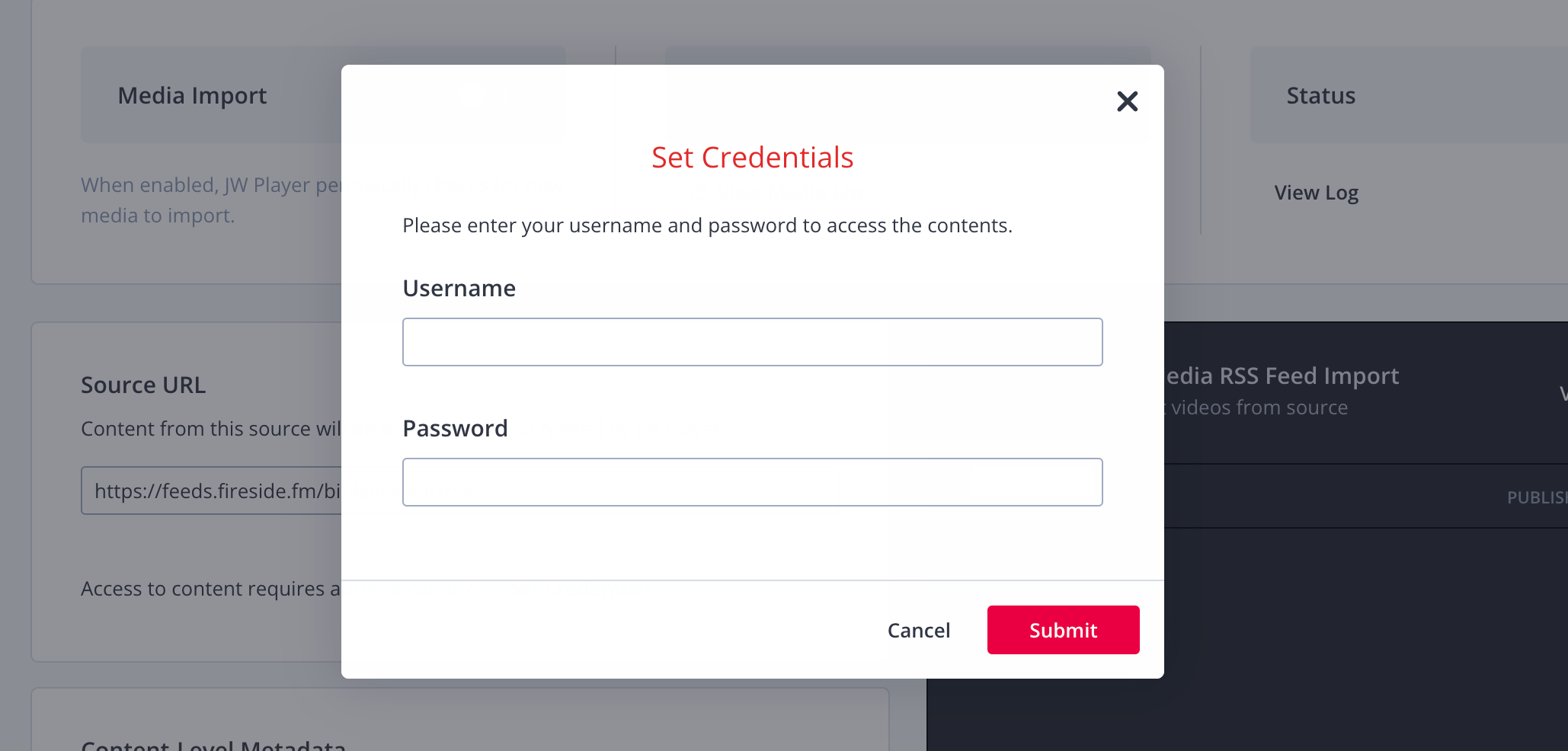
Set credential screen
Some feeds have security enabled to prevent someone from gaining unauthorized access.
If the MRSS feed you want to import requires authentication, use the following steps to set the credentials to enable access to the media in the feed:
- Under Source URL, click Set Credentials. The Set Credentials popup window appears.
- Enter the Username and Password for the MRSS feed.
- Click Submit. The import system will use these credentials for authentication.
Content-Level Metadata

Content-level metadata setting
If the imported media has the following items defined in the feed, this information is used to populate the relevant metadata for the media:
media:descriptionmedia:textmedia:thumbnail
This applies only to JWX-hosted content. Non-hosted, registered content will not contain any thumbnail information.
pubDate
The following table shows how the feed data for the media is mapped to the media metadata option in your JWX dashboard.
| JWX Content-Level Metadata | MRSS Element |
|---|---|
| Captions | media:subTitle |
| Description | media:description |
| Publish Date | pubDate |
| Thumbnails | media:thumbnail |
If you prefer to prevent JWX from automatically mapping the feed data to the media metadata, follow these steps:
- Scroll to the Content-Level Metadata section.
- Click the checkbox next to the media metadata to be excluded during the import for each media. Since all media metadata checkboxes are selected by default, this step unchecks the metadata to exclude.
Tags

Tags and Content-Level Tags settings
Tags
A tag is a label applied to a media. When applied to a media, tags can be used for searching, sorting, and filtering JWX playlists.
Use the following steps to add tags to all videos that are imported from this MRSS feed:
- On the Tags tab, choose to add a Single tag or Multiple Tags.
- Enter the tag information:
- For a Single tag, enter the tag.
- For Multiple Tags, enter a comma-separated list of tags.
- Click Add.
Content-Level Tags
If the imported media has media:category, media:credit, media:keywords, or media:tags defined in the feed, the information of each element is used to create tags for the imported media.
If you prefer to prevent JWX from automatically adding these tags to imported media, follow these steps:
- Scroll to the Content-Level Tags section.
- Click the checkbox next to the tag information to be excluded during the import for each media. Since all tag checkboxes are selected by default, this step unchecks the tag information to exclude.
Advanced Content-Level Tags
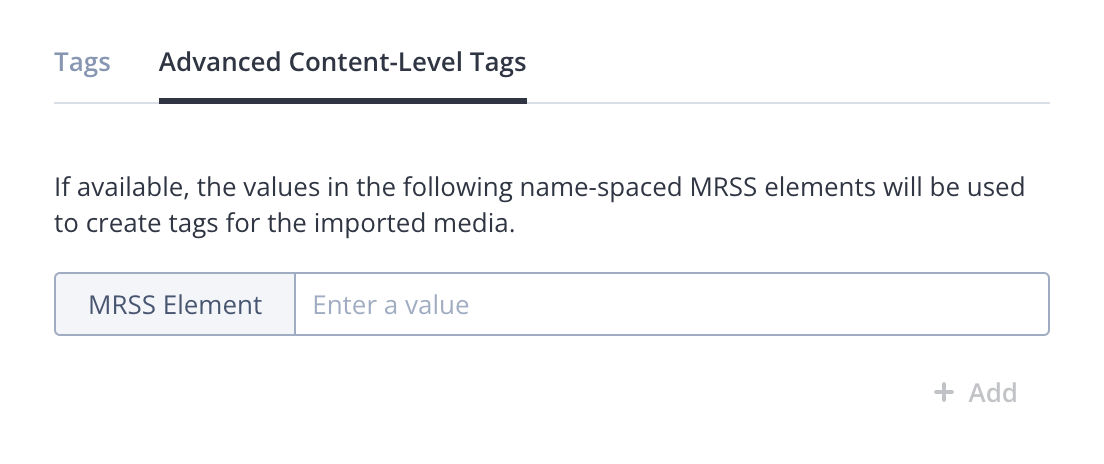
Advanced Content-Level Tags
Advanced Content-Level Tags are created from the values of custom namespaced elements in an MRSS feed. The value of an element is then applied to each media as a tag.
For example, the following is an example of a custom namespaced element from an MRSS feed.
<jp:locationType>Mountains</jp:locationType>
The namespace element (jp:locationType) can be added in the Advanced Content-Level Tags section of your JWX dashboard. For all imported media containing the jp:locationType element, the value of the element is applied as a tag to the media. Using the previous example, a Mountains tag would be applied to the media.
The tags created from custom namespaced elements can be used for searching, sorting and filtering JWX playlists.
On the Custom Content-Level Tags tab in the MRSS Element text box, add the element name.
Follow these steps to add a advanced content-level tag:
- On the Advanced Content-Level Tags tab in the MRSS Element text box, add the element name.
- Click + Add.
Custom Parameters
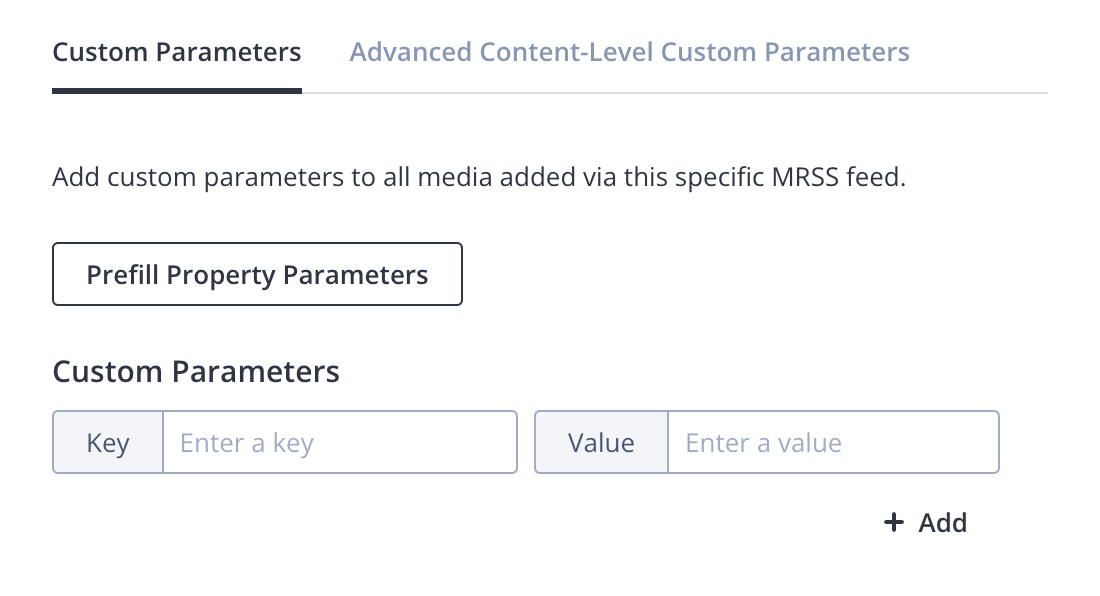
Custom Parameters settings
Custom Parameters allow for custom information to be imported with the JWX videos.
Custom Parameters
- Enter a Key and Value for each custom parameter that will be added to every video imported from this MRSS feed.
Do not begin a key with a number. When a key begins with a number, invalid XML elements are introduced into the MRSS feed.
- (Optional) Click + Add to apply additional custom parameters.
You can click Prefill Property Parameters to add the default custom parameters of the property to a video.
Advanced Content-Level Custom Parameters
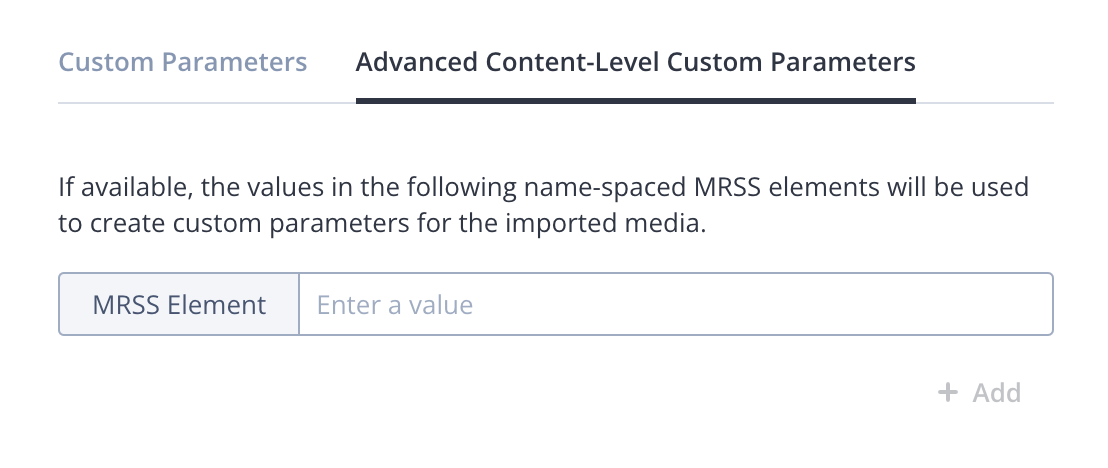
Advanced Content-Level Custom Parameters settings
Advanced Content-Level Custom Parameters are created by parsing custom namespaced elements in an MRSS feed and importing it as a custom parameter on the associated video.
Follow these steps to set Advanced Content-Level Custom Parameters:
- On the Advanced Content-Level Custom Parameters tab in the MRSS Element text box, add the element name.
- Click + Add.
<jp:locationType>Mountains</jp:locationType>
In this example, a custom parameter with the key locationType and value Mountains will be added to the JWX video.
There can only be one unique key per video. If there is more than one custom parameter for the media item with the same key, then only the first will be imported.
The custom namespaced values must be at the first level under the individual video element in the MRSS XML to be imported.
XML attributes are not used for the key or value of the custom parameter.
FAQs
Is there an MRSS specification?
Yes. The Media RSS Specification is maintained by the RSS Advisory Board.
What media formats are supported with MRSS feed imports?
While JWX can accept many media formats, we recommend uploading .aac, .mp3 .mp4, .ogg, or .webm files.
The following tables list all media formats that can be included in an MRSS feed. Rows denoted with an asterisk (*) are recommended formats that the player officially supports. Other accepted formats will be transcoded into an appropriate format when uploaded.
Be aware that neither an HLS nor DASH stream is supported in an MRSS feed.
Video Formats
| Name | Mime Type / Internet Media Type | File Extension |
|---|---|---|
| * MPEG-4 | video/mp4 | .mp4 |
| * WebM | video/webm | .webm |
| 3GP | video/3gpp | .3gp |
| H.264 | video/h264 | .h264 |
| Microsoft Windows Media | video/x-ms-wmv | .wmv (excluding videos using MSS2 video codec) |
| MPEG | video/mpeg | .mpeg |
| MPEG transport stream | video/MP2T | .tsv |
| Ogg | video/ogg | .ogv |
| Quicktime | video/quicktime | .mov (excluding videos using Apple Intermediate Codec) .qt |
Audio Formats
| Name | Mime Type / Internet Media Type | File Extension |
|---|---|---|
| * Advanced Audio Coding | audio/aac | .aac |
| * MP3 | audio/mpeg | .mp3 |
| * Ogg (Vorbis) | audio/ogg | .ogg |
| MPEG-4 Audio | audio/mp4 | .mp4a |
| WebM | audio/webm | .webm |
| Waveform Audio Format | audio/wav | .wav |
You can read more about video preparation.
Updated 14 days ago

